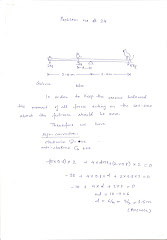Now, let us discuss a problem related to Newton's first law of motion so that we understand the application of the equations of motions which are
(i) v = u + at
(ii) s = ut + 1/2 at^2
(iii) v^2 = u^2 + 2as
These are the three basic equations of motion which can be used to solve problems of kinematics if the acceleration is constant.
If you are seeking a more general form then you have to use the basic differential form of these
equations
(i) v = ds /dt
(ii) a = dv/dt
(iii) a = vdv/ds
Using these equations it is possible to solve any problem of kinematics.
Example: A car traveling at a velocity of 10 m/s is stopped by the driver by applying brakes when he is at distance of 30 m from a wall. The maximum retardation possible is 2m/s^2?
Will the driver be able to avoid collision?
Solution:
Given in the problem that initial velocity = 10 m/s
final velocity = 0 m/s (since the car will be at rest)
The maximum retardation is given as 2m/s^2
We can use the equation
v^2 = u^2 + 2as
u = 10 m/s
a = -2m/s^2
v = 0 m/s
Putting these values in the equation we get
0 = 10^2 + 2.(-2).s
4s = 100
s = 25 m
Luckily the driver will manage to avoid the collision!
I will be back with more interesting problems for all you physics enthusiast.
Subscribe to:
Post Comments (Atom)





No comments:
Post a Comment